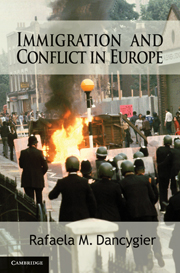Book contents
- Frontmatter
- Contents
- List of Figures and Tables
- Acknowledgments
- PART I GENERAL INTRODUCTION AND THEORETICAL FRAMEWORK
- PART II INTRODUCTION TO PART II
- PART III INTRODUCTION TO PART III
- PART IV INTRODUCTION TO PART IV
- 9 Conclusion
- Appendix A Coding Large-Scale Instances of Immigrant–Native and Immigrant–State Violence
- Appendix B Data and Variables: Immigrant Turnout
- References
- Index
- Titles in the series
PART IV - INTRODUCTION TO PART IV
Published online by Cambridge University Press: 17 November 2010
- Frontmatter
- Contents
- List of Figures and Tables
- Acknowledgments
- PART I GENERAL INTRODUCTION AND THEORETICAL FRAMEWORK
- PART II INTRODUCTION TO PART II
- PART III INTRODUCTION TO PART III
- PART IV INTRODUCTION TO PART IV
- 9 Conclusion
- Appendix A Coding Large-Scale Instances of Immigrant–Native and Immigrant–State Violence
- Appendix B Data and Variables: Immigrant Turnout
- References
- Index
- Titles in the series
Summary
The accounts of Tower Hamlets and Ealing and of Birmingham and Leicester have illuminated the specific developments and mechanisms that connect immigrants to electoral power; tie electoral power to access to scarce economic goods; and link up immigrants' access to such goods to conflict outcomes. Moreover, they have shown that conflict outcomes can vary within the immigration and citizenship frameworks of one country, variation which is in turn a function of immigrant electoral behavior and local political economies.
The remainder of this book brings the significance of national institutions and their interplay with local political economies into sharper relief. Chapters 7 and 8 investigate the implications of immigration and citizenship regimes for the economic and electoral variables that shape local-level immigrant–native and immigrant–state conflict. Chapter 7 explains immigrant conflict outcomes in Germany where guest-worker migration took place within the confines of a coordinated immigration regime and a closed citizenship framework. These institutions thus diverge from Britain's relatively uncoordinated arrival of migrants and its more liberal nationality code. Chapter 8 then turns to France, whose national postwar immigration regime and citizenship laws more closely resemble those of Britain, but whose local electoral institutions have been more difficult to penetrate by immigrant-origin newcomers, especially when set against the comparatively open ward-level system in which Britain's immigrant minorities have competed. Put differently, when juxtaposing Britain and France, the analysis reveals that similar national immigration and citizenship institutions meet differences in the parameters that shape local immigrant political power across countries.
- Type
- Chapter
- Information
- Immigration and Conflict in Europe , pp. 219 - 220Publisher: Cambridge University PressPrint publication year: 2010

